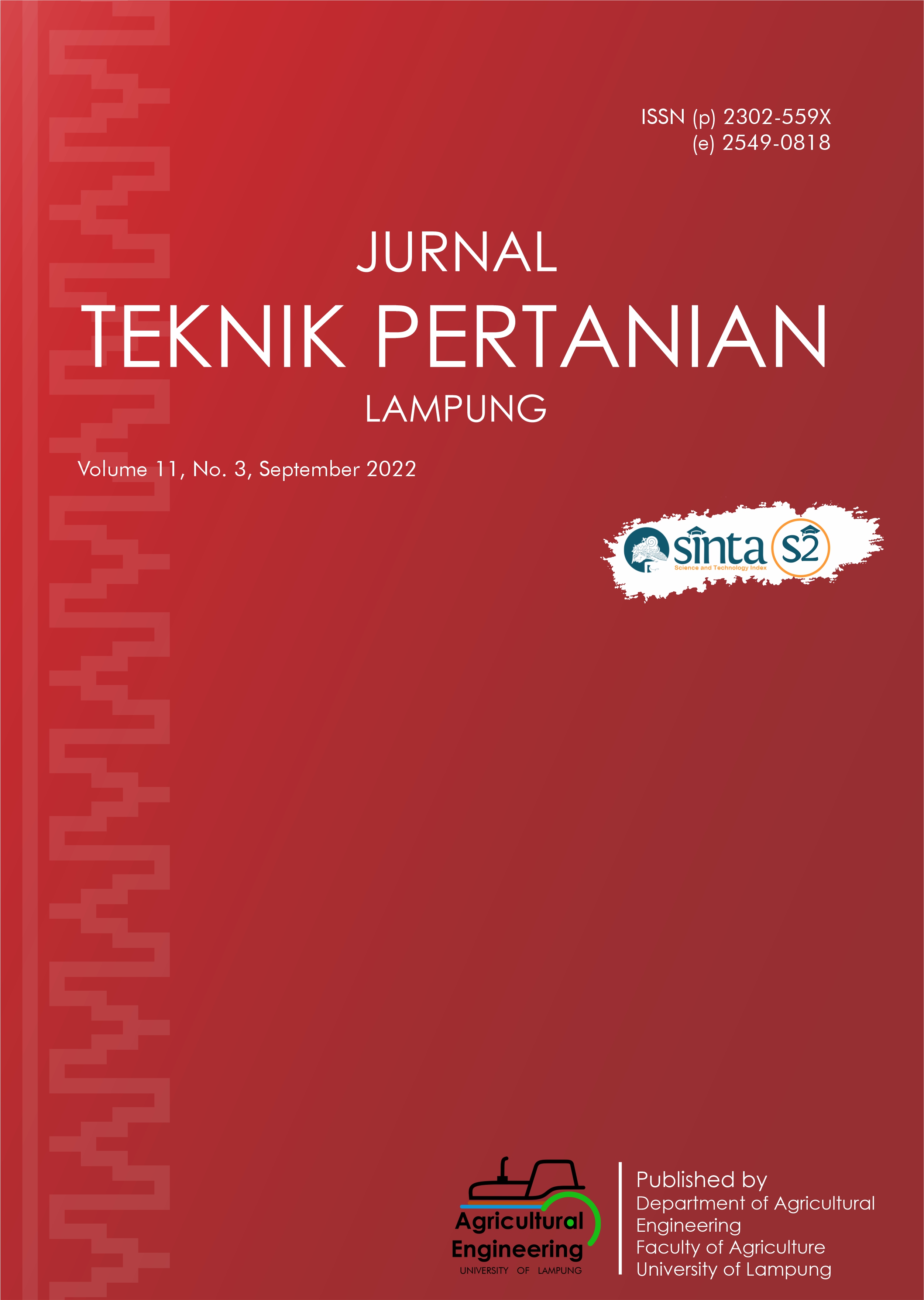Placement Precision of Organic Fertilizer Based on Soil Conservation in Taro Cultivation
DOI:
https://doi.org/10.23960/jtep-l.v11i3.396-404Abstract
One of the things that are important to consider when fertilizing is how to place the fertilizer so that plants can consume nutrients efficiently. The research objective was to assess the precision of soil conservation based on fertilizer placement so that fertilizers could increase the production of taro effectively. This study applied four treatments, namely without fertilizer, placing manure in the planting hole, placing manure in the biopore, and placing manure on the borders. The three treatments were given 1 kg of goat manure. The treatment was performed with six replications. Harvesting is carried out in 8 months after planting. The results showed that the placement of manure on the borders was the most effective treatment with the highest yield of wet tubers of 21.4 Mg/ha and was not different from the treatment of manure in biopore 18.3 Mg/ha.This yield was different significantly as compared to that of resulted from treatments where fertilizer was placed in the planting hole (15.9 Mg/ha) or the production of taro without manure application (11.57 Mg/ha).
Keywords: Organic fertilizers, production, soil conservation, taro
References
Adejumo, I. (2013). Colocasia esculenta (L.) Schott as an alternative energy source in animal nutrition. British Journal of Applied Science & Technology, 3(4), 1276-1285. https://doi.org/10.9734/bjast/2014/4945
Bardhan, K., York, L.M., Hasanuzzaman, M., Parekh, V., Jena, S., & Pandya, M.N. (2021). Can smart nutrient applications optimize the plant’s hidden half to improve drought resistance? Physiologia Plantarum, 172(2), 1007-1015. https://doi.org/10.1111/ppl.13332
Boampong, R., Boateng, S.K., Adu Amoah, R., Adu Gyamfi, B., Aboagye, L.M., & Ansah, E.O. (2020). Growth and yield of taro (Colocasia esculenta (L) Schott.) as affected by planting distance. International Journal of Agronomy, 2020, 1-8: https://doi.org/10.1155/2020/8863099
De Oliveira, F.L., Guerra, J.G.M., Ribeiro, R.D.L.D., De Almeida, D.L., Da Silva, E.E., Urquiaga, S., & Espindola, J.A.A. (2007). The use of sunn hemp as green manure intercropped with taro. Horticultura Brasileira, 25(4), 562-566. https://doi.org/10.1590/S0102-05362007000400013
Donjadee, S., & Tingsanchali, T. (2016). Soil and water conservation on steep slopes by mulching using rice straw and vetiver grass clippings. Agriculture and Natural Resources, 50(1), 75–79. https://doi.org/10.1016/j.anres.2015.03.001
Juang, K.W., Lin, M.C., & Hou, C.J. (2021). Influences of water management combined with organic mulching on taro plant growth and corm nutrition. Plant Production Science, 24(2), 152-169 https://doi.org/10.1080/1343943X.2020.1820877
Liu, J., Zang, C., Tian, S., Liu, J., Yang, H., Jia, S., You, L., Liu, B., & Zhang, M. (2013). Water conservancy projects in China: Achievements, challenges and way forward. Global Environmental Change, 23(3), 633–643. https://doi.org/10.1016/j.gloenvcha.2013.02.002
Mangallo, B., Taberima, S., & Musaad, I. (2018). Utilization of extract tailings and cow manure for increasing of soil quality and uptake of micronutrients of Xanthosoma sagittifolium (L.) Schott on sub optimal land of Wondama. Indian Journal of Public Health Research and Development, 9(8), 1456-1460. https://doi.org/10.5958/0976-5506.2018.00937.3
Miyasaka, S. C., Hollyer, J. R., & Kodani, L. S. (2001). Mulch and compost effects on yield and corm rots of taro. Field Crops Research, 71(2), 101-112. https://doi.org/10.1016/S0378-4290(01)00154-X
Nurchaliq, A., Baskara, M., & Suminarti, N.E. (2014). Pengaruh jumlah dan waktu pemberian air pada pertumbuhan dan hasil tanaman talas (Colocasia esculenta ( L .) Schott var . Antiquorum ). Jurnal Produksi Tanaman, 2(5), 354-360.
Nurilmala, F., & Mardiana, D. (2019). Nutrients and anti-nutrients content analysis of bogor taro mutant clone (Colocasia esculenta). IOP Conference Series: Earth and Environmental Science, 334(1), 1-5. https://doi.org/10.1088/1755-1315/334/1/012070
Pongener, N., & Daiho, L. (2016). Survey on leaf blight of taro (Phytophthora colocasiae Raciborski) in Nagaland. Acta Horticulturae, 1118, 125-130. https://doi.org/10.17660/ActaHortic.2016.1118.18
Rop, K., Karuku, G. N., Mbui, D., Njomo, N., & Michira, I. (2019). Evaluating the effects of formulated nano-NPK slow release fertilizer composite on the performance and yield of maize, kale and capsicum. Annals of Agricultural Sciences, 64(1), 9–19. https://doi.org/10.1016/j.aoas.2019.05.010
Syarif, Z., Akhir, N., & Satria, B. (2017). Identification of plant morphology of taro as a potential source of carbohydrates. International Journal on Advanced Science, Engineering and Information Technology, 7(2), 573-579. https://doi.org/10.18517/ijaseit.7.2.1323
Temesgen, M., & Retta, N. (2015). Nutritional potential, health and food security benefits of taro Colocasia esculenta (L.): A review. Food Science and Quality Management, 36, 23-30.
Downloads
Published
Issue
Section
License
- Authors who publish with this journal agree to the following terms:
- Authors retain copyright and grant the journal right of first publication with the work simultaneously licensed under a Creative Commons Attribution-ShareAlike 4.0 International Lice that allows others to share the work with an acknowledgement of the work's authorship and initial publication in this journal.
- Authors are able to enter into separate, additional contractual arrangements for the non-exclusive distribution of the journal's published version of the work (e.g., post it to an institutional repository or publish it in a book), with an acknowledgement of its initial publication in this journal.
- Authors are permitted and encouraged to post their work online (e.g., in institutional repositories or on their website) prior to and during the submission process, as it can lead to productive exchanges, as well as earlier and greater citation of published work (See The Effect of Open Access).
Jurnal Teknik Pertanian Lampung

JTEPL is licensed under a Creative Commons Attribution-ShareAlike 4.0 International License.

